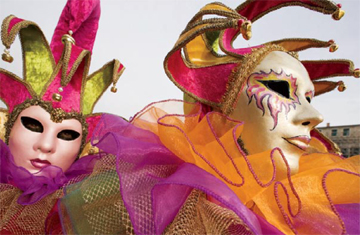
LIGHT WALK: Constitution Bridge
When Napoleon invaded Venice in 1797 he was so shocked at the excesses of the annual Carnival he banned it. No wonder. In the dying days of the Venetian Republic, the festival's decadence knew few bounds, with masked merrymakers streaming into casinos to gamble, partygoers indulging in illicit liaisons, and crowds calling for blood at bullfights. Today the pre-Lenten event is more family-friendly. But there's still a touch of hedonism as fancy-dress parties, concerts, fashion parades and firework displays transform the city into a vast alfresco theater. (See pictures of Italy.)
This year, the 10-day Carnival kicks off on Feb. 14. To soak up the scene before the crowds descend, visit St. Mark's Square on the first morning. An outdoor table at the 18th century coffee-house Florian offers a ringside view of the counts, sultans and harlequins as they swan about the piazza.
When it's time to join the fun, kit yourself out with a mask from MondoNovo in the Dorsoduro quarter. Every inch of wall space in this grottolike shop is hung with elaborate masks skillfully handpainted in vibrant colors. "The secret of wearing a mask is to invent a personality for yourself and interact with the people around you," says master maskmaker Guerrino Lovato, whose papier-mâché creations were worn by Nicole Kidman in Stanley Kubrick's Eyes Wide Shut. (See pictures of the glitz and glamour at the Venice Film Festival.)
In keeping with the Carnival spirit, the Palazzo Barbarigo is a great place for a steamy rendezvous. Located near the Rialto Bridge, the 16th century palace has been transformed into a moody, Art Deco–style hotel. Its slinky cocktail bar with dark velvet upholstery, smoky mirrors and a view of the Grand Canal is proving a fashionable hangout for locals and visitors alike. (See pictures of Venice's floods.)
Splendid as Palazzo Barbarigo is, it's a shame to see so many Venetian palaces used as hotels. Good news, then, that after a 20-year restoration, the 16th century Palazzo Grimani has opened as a museum. The palace boasts doorways carved from precious marble, exquisite frescoes, majolica-tiled fireplaces and rare surviving examples of pastellone (powdered marble) floors.
Venice's historic treasures have one drawback: they can dupe visitors into believing the city is stuck in a time warp. For a taste of the 21st century, check out the new restaurants on the Grand Canal's south bank. Ancora is the latest to cause a stir with its all-white décor, nightly jazz sessions and Mediterranean-with-a-twist menu — try the raw tuna and avocado salad with kabayaki sauce, or the bass with olive oil and white beans.
But Venice's most significant break with tradition is the new bridge across the Grand Canal. Designed by Spanish architect Santiago Calatrava, Constitution Bridge — which connects Santa Lucia rail station and the Piazzale Roma bus terminal — caused controversy at first. Now, however, its swooping glass-and-steel curve has become the signature of a city that knows how to have fun.
